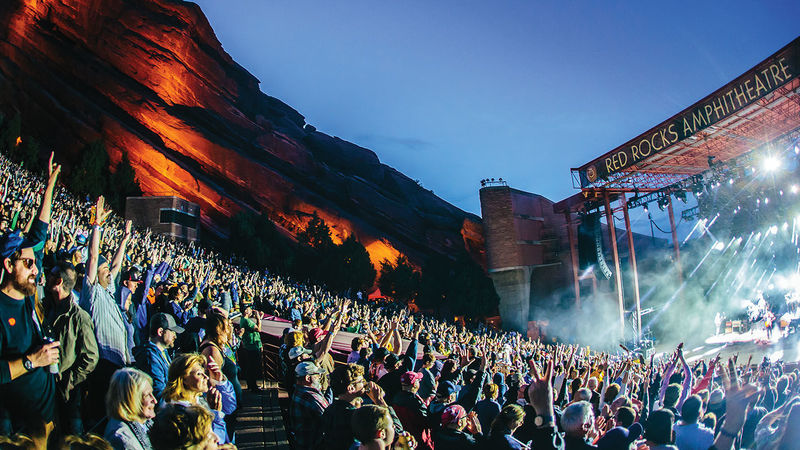In a few hours, Ryan Stasik ’99 will take the stage at one of music’s most iconic venues. For now, however, sitting in a small room high in the Rocky Mountains, wearing a “World’s Okayest Bass Player” T-shirt, his thoughts have drifted two decades into the past to a house 1,000 miles away and a conversation that changed the course of his life.
It started as a confrontation. Stasik had recently formed a band with a few other Notre Dame students, but lead singer Brendan Bayliss ’98 had missed several rehearsals. Stasik went to Bayliss’ house just south of campus on St. Peter Street and pleaded with his friend to take their band more seriously. With the aid of some Mishawaka Brewing Company beers, he got through to Bayliss, and soon the intervention had morphed into a pact.
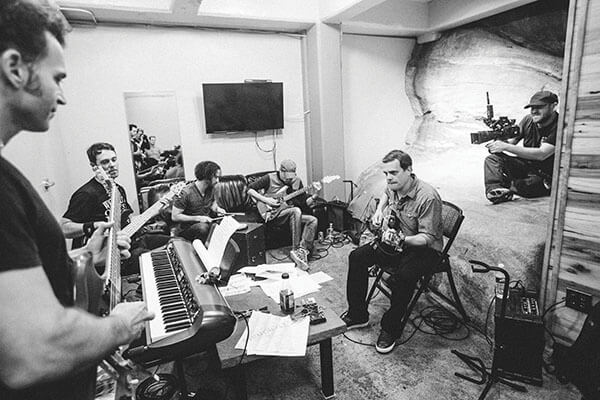
There was nothing official about it. No papers were signed. But that night, Stasik and Bayliss made a promise to one another. “I’m going to make music with you for the rest of my life,” Stasik remembers saying.
It was the type of bold declaration college buddies often make, only to part ways at graduation, slowly drift apart and eventually forget they’d ever hatched such a grandiose plan. But Stasik and Bayliss really meant it, and, so far, they’ve made good on it.
- From the Back of the Racks
- The Ballad of Umphrey’s McGee
You can trace a long, meandering path from that late-night pledge to this practice room carved into the side of a mountain one level beneath the stage at the legendary Red Rocks Amphitheatre in Morrison, Colorado. Six hours after he’s done reminiscing, Stasik is strutting around the center of the stage with his bass guitar. To his immediate left, Bayliss plays guitar and sings into his microphone, facing a tidal wave of 8,775 dancing fans and two enormous red sandstone rocks stretching high into the night sky. They’re 6,400 feet above sea level and a world removed from that college rental house on St. Pete Street.
Stasik and Bayliss represent a third of the current lineup of Umphrey’s McGee, a rock and roll band formed by four Notre Dame students in 1997. Along with keyboardist and co-founder Joel Cummins ’98, percussionist Andy Farag, guitarist Jake Cinninger and drummer Kris Myers, they’ve grown from an unknown, unruly outfit playing in front of their friends in South Bend bars to an act that can headline — and sell out — Red Rocks two nights in a row on a Fourth of July weekend.
Umphrey’s McGee’s musical style has always been difficult to categorize. ‘Self-indulgent, improvisational rock and roll,’ Stasik says, when asked to put a label on it.
The climb hasn’t been easy. No smash-hit single exploded on radio stations and turned them into overnight stars. Making it this far has required an unyielding dedication to their crafts and to each other. But, as Bayliss is fond of pointing out, they have never needed to get “real jobs.” And they’ve proven that some seemingly fanciful college dreams really do come true.
Notre Dame is an unlikely place for the Umphrey’s McGee story to begin. It has never been known to have a particularly bustling student music scene or, with apologies to Ted Leo ’94, to graduate rock stars. Yet when Stasik arrived in the fall of 1995, the Pittsburgh native who began piano lessons at 5 and transitioned to the guitar as a teen was on the lookout for musicians.
“When I came to Notre Dame, I wasn’t so sure about my major, but I was positive that I wanted to be in a band with somebody,” he says.
During his freshman year, Stasik made the short walk from Alumni Hall to the LaFortune Student Center to take in AcoustiCafé, a regular open mic night for student performers. He came across a sophomore playing the banjo and singing “Rainbow Connection,” the song made famous by Kermit the Frog in The Muppet Movie. “I want to make music with that guy,” Stasik thought.
That guy was Bayliss, the son of former longtime Notre Dame men’s tennis coach Bobby Bayliss. A guitarist and singer, he had formed a band during his freshman year with some fellow alumni of South Bend’s St. Joseph High School but eventually was kicked out for missing a few shows and rehearsals. Stasik introduced himself, and the pair soon started jamming in the basement of Keenan Hall.
Bayliss and Stasik formed Tashi Station and played original music and covers at student parties and South Bend bars. It was during their stint with this group that the two struck their late-night pact. “We were both all in, and everything else became second priority,” Bayliss says.
They didn’t want playing in a band to be something they only did for fun on the weekends in college; they were determined to become professional, working musicians. And by the fall of 1997, with Bayliss’ graduation looming in the spring, they didn’t think the other members of Tashi Station shared that goal.
Meanwhile, Stomper Bob, another student outfit, was playing mostly cover songs at similar venues, often to larger crowds. Cummins, a senior music and theology major from the suburbs of Chicago, played keyboards for the group. He and Mike Mirro ’00, a sophomore at the time, also harbored dreams of extending their musical careers beyond college.
Stasik and Bayliss came to Cummins and Mirro near the end of that semester with a proposal: Each duo would drop out of their respective bands, and the foursome would start a new one that would continue after Bayliss and Cummins graduated in the spring. Both sides had some uncomfortable conversations with their current collaborators, and a new Notre Dame student band was born.
After weeks of rehearsal and teaching each other some of their respective original songs, the group made their live debut on January 21, 1998, at Bridget McGuire’s Filling Station in South Bend. As they launched into “Bob,” a song co-written by Bayliss and Stasik, disaster struck. “Within the first 20 seconds, the power went out on the stage,” Cummins says. “We were in a drum solo. That was how we began our illustrious career.”
A week later, Bridget McGuire’s was raided by the police, who discovered that a majority of the patrons inside were under 21, causing the bar to permanently shut down. The four members of this new band joked that they hoped these weren’t signs of things to come.
Undeterred, they booked more gigs. They initially performed as “Fat Tony,” a temporary name inspired by the mobster character on The Simpsons. The search for a permanent moniker concluded late one night at Club 23, another now-defunct student bar.
It’s a story Bayliss has shared hundreds of times and doesn’t seem eager to tell again. At his brother’s wedding a few years earlier, Bayliss had been amused to meet a distant cousin with an unusual name: Humphreys McGee. This name was made even more memorable by this cousin’s Southern accent, which caused him to drop the “H” in “Humphreys.” For some reason, this stuck in Bayliss’ head, so he brought it up as an option that night at Club 23. Maybe it was the Long Island Iced Teas, but the rest of the band jumped on board, and the name stuck.
Eighteen years later, Bayliss is convinced the band would have more success today with a name that sounds a bit less like a group that plays Irish drinking songs. “We were college kids,” he says. “We weren’t very forward-thinking.”
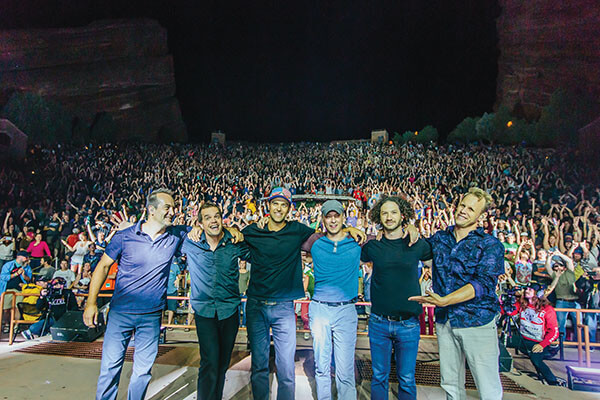
Yet Umphrey’s McGee began to move forward. Band members started playing regular shows at a host of South Bend bars, most of which either no longer exist or operate under new names. Club 23. Irish Connection. Finnegans. The State Theater. Mickey’s Pub. They performed at parties at student houses on Marion Street and Notre Dame Avenue and played campus shows at Stepan Center and in front of Stonehenge.
A fan base began to emerge. It started with friends of the band, then friends of friends showed up. Cummins still remembers the moment after one early show when he asked an audience member which guy in the band he knew. No one, the Notre Dame graduate student said. He just really liked the band. It’s our first real fan, Cummins thought.
By the time the fall semester of 1998 rolled around, Umphrey’s McGee had released its first album, Greatest Hits Vol. III, which was recorded in a Napa Auto Parts in South Bend. The initial 400 CDs sold by the first week of September. A second album, Songs for Older Women, was recorded live at Madison Oyster Bar the following year.
As the song catalog grew, the temptation to leave South Bend and its relatively limited music scene grew stronger. But band members committed to wait until Mirro graduated in 2000. On some weekends, they’d drive to Indianapolis, Milwaukee, Cincinnati or other nearby cities where they could schedule shows. But for most of its first two and a half years as a band, Umphrey’s McGee honed its sound in Michiana.
“I really think that time in South Bend was incredibly valuable for just developing and having a stage where it wasn’t a huge deal for us to try something and fall on our faces and be like, ‘OK, that didn’t work. Back to the drawing board,’” Cummins says.
In the summer of 2000, Umphrey’s McGee left its musical birthplace behind and relocated 100 miles west to Chicago. The entire band moved into a house near Wrigley Field and used the basement as a rehearsal space. Each month, the musicians would pool whatever money they had made playing gigs to pay the rent and utilities and then split whatever was left. It wasn’t much, which meant they couldn’t afford to have particularly vibrant social lives. Instead, they stayed home and practiced together for hours on end.
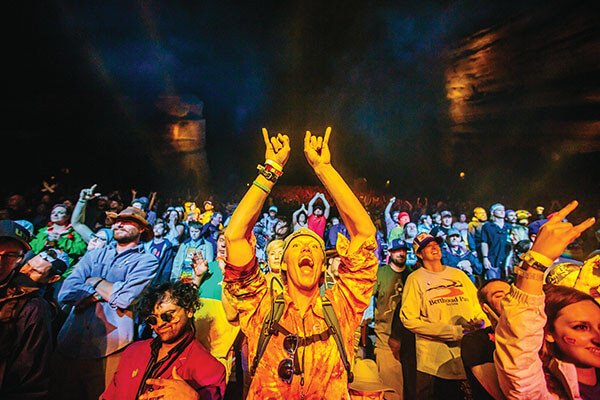
Location wasn’t the only thing changing for Umphrey’s McGee; its lineup had also been evolving. Farag was the earliest addition. A self-taught percussionist who plays a range of instruments on stage, from congos and bongos to timbales and cowbells, he had gone to high school with Mirro in Crown Point, Indiana. During the band’s first year, he would frequently make the trip up from Bloomington, where he attended Indiana University, to sit in on a few songs. When he was invited to join full time, Farag transferred to IU’s South Bend campus.
Cinninger was next. Growing up in Niles, Michigan, just over the state line from South Bend, he was, essentially, a musical prodigy, although he’s too modest to use that language himself. He started out as a drummer, and by age 11 he was playing professionally just about every weekend alongside grown men. He later learned guitar (and a slew of other instruments) and was part of several bands throughout his teens and early 20s. He came into the Umphrey’s McGee orbit as a member of Ali Baba’s Tahini, a local South Bend band playing a similar style of progressive, experimental music.
The two bands became friendly, and Bayliss, wowed by Cinninger’s knack for complex guitar solos, took a few lessons from him. During these sessions, the two noticed how well they sounded together. “There was something really special between the way we interacted with ideas,” Cinninger says. “We could kind of finish each other’s sentences.” Hoping to capitalize off this musical synergy, Umphrey’s McGee members invited Cinninger to jump on board shortly after the move to Chicago.
Within days of their move, they started touring around the country. They’d head out on the road for weeks at a time, trading shifts driving a 1995 Chevrolet Suburban they called Grendel (named for the monster in Beowulf) and piling into cheap motel rooms or crashing at apartments belonging to friends from Notre Dame. Before their shows, they’d visit local colleges and pass out hundreds of fliers, trying to attract a crowd and win over new fans.
“It was the time of our lives,” Stasik says. “It was super fun. We were seeing a lot of the United States as a band of brothers for the first time. Getting paid to play music. Staying up late. Having a good time like young boys do.”
They faced a crisis in 2002 when Mirro informed his five bandmates he was leaving the band to attend medical school. Faced with the prospect of breaking up or forging on without one of its founders, Umphrey’s McGee got the word out that they were in need of a new drummer.
A huge stack of audition tapes came in. The first one the team opened belonged to Myers, who had recently finished a graduate degree in jazz studies at DePaul and was playing with Kick the Cat, a jazz fusion group in Chicago. After an in-person audition, Myers was invited to join in the fall of 2002. Umphrey’s McGee has had the same lineup ever since.
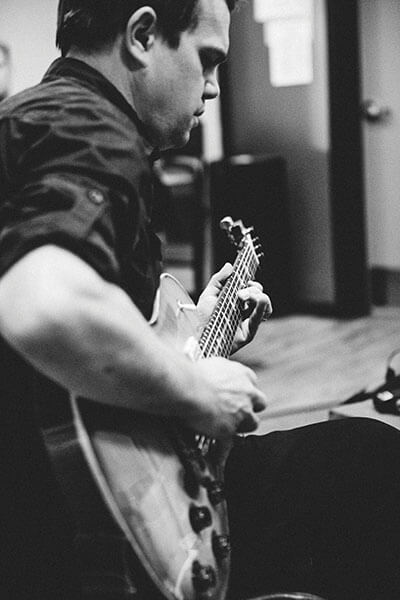
As the band grew, so did its audience. The relentless touring schedule — as many as 160 concerts in a single year — started to pay off. Umphrey’s McGee began to play in larger venues.
There were pivotal moments along the way. In 2002, the band accepted an invitation to play at a new outdoor music festival in Tennessee called Bonnaroo. Going in, no one knew what to expect. When they walked out on stage for their set, a band that was used to playing in front a few hundred people was greeted by roughly 10,000. “It felt like, OK, now we’re playing about 25 or 30 shows in one show here,” Cummins says. They sold CDs and merchandise, and an untold number of festival-goers returned to their homes as new Umphrey’s McGee fans. The band played Red Rocks for the first time in 2005, opening for the String Cheese Incident.
Of course, the most important factor in the group’s still-growing popularity has been the music. The musicians have released nine studio albums and have always encouraged fans to tape their live shows and share the music. They even hand out a few free tickets to audio-tapers.
Umphrey’s McGee’s musical style has always been difficult to categorize. “Self-indulgent, improvisational rock and roll,” Stasik says, when asked to put a label on it. They’re frequently referred to as a jam band because, like Phish and the Grateful Dead, they’re prone to break into long, complex improvisations during live shows. But their music often has a harder edge to it than those bands, and they seem to effortlessly move between and blend together a number of different genres: progressive rock, heavy metal and electronic dance music, to name a few.
This diversity of sounds stems largely from the democratic nature of the band and the varied backgrounds and interests each member brings to the table. Ask each one to name his biggest musical influences, and you get an eclectic mix of answers, from the Beatles and Guns N’ Roses to Frank Zappa, Miles Davis and the Beastie Boys.
Rather than forcing themselves to fit into a certain category, Umphrey’s McGee members have embraced a level of unpredictability that many bands would shy away from. They experiment with their songwriting, embrace new challenges and rehearse enough — on their own and as a group — to master varied genres and techniques.
“When we play these styles, we mean it,” Cinninger says. “It’s not just tinkering around with metal. We’re going to execute it properly.”
The one constant is improvisation. That might be why Umphrey’s McGee has become such a popular live act. No one show is ever the same as the next one. While this is partially due to their massive song catalog, it’s also because any given song can sound different at any given show. Each member of the band can initiate an improvisation, taking a song in some new direction. The other five are ready to follow the lead and add additional new layers of their own. On stage, the musicians communicate through a system of hand signals and talkback microphones, and their shared musical instincts and years of playing together allow them to seamlessly complement each other’s improvisations. The uninitiated concert-goer might think the whole performance was rehearsed and planned.
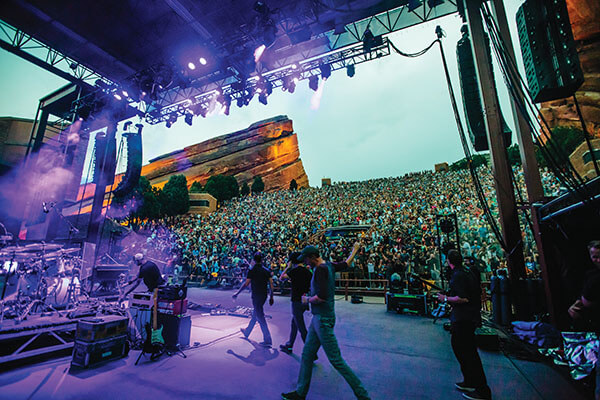
Seeing the band in person allows for a fuller appreciation of its artistry. The average music fan, someone who is not a musician, usually listens to a song and enjoys the totality of it. Watching a live performance lets that same amateur clearly see and hear the component parts and marvel at how they come together to create a complex yet coherent finished product.
On stage at Red Rocks, Myers and Farag, the drummer and percussionist, are positioned behind their four bandmates, but your eyes are drawn to them. They’re in nonstop motion, providing the pulse for each song and seemingly communicating with each other on an unspoken level. The sounds of Bayliss’ and Cinninger’s guitars blend together at times but are distinct a second later. Your eyes and ears can align to key in on Stasik’s bass line or the melodies flowing from Cummins’ keyboards.
It’s obvious how much they enjoy playing music with each other. Cinninger and Bayliss seem to relish watching each other break into guitar solos. For one stretch of time, Stasik turns his back to the audience so he can face Myers and Farag; he dances and bobs his head in solidarity with his fellow rhythm section members.
Their love for the fans is just as obvious. Throughout both shows, different band members thank the crowd for coming out. On more than one occasion, Stasik looks out on the crowd, raises two fists above his head and brings them together while lifting both pinkies straight up to form the letter “U.” It’s a familiar salute to the diehards in attendance, who throw up their own U’s and roar with approval.
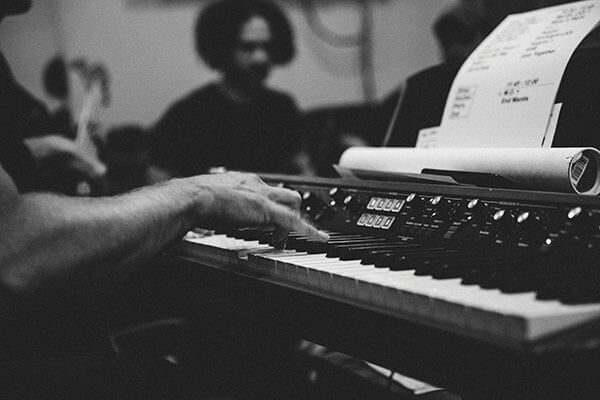
The audience loves them back, of course. Almost all of the fans remain standing — and dancing — throughout the concerts, which last more than three hours. Early in the show on the first night, the group plays one of its most popular songs, “In the Kitchen.” When Bayliss belts out the line, “I was short on opinions and I wanted to know if you’d still be here tomorrow,” the crowd erupts. Many of them will be back tomorrow, apparently.
The musical versatility of Umphrey’s McGee is also on full display at Red Rocks. On night two, a harder edge comes through on the opening guitar riffs of “In the Black.” Two songs later, Bayliss puts down his electric guitar in favor of an acoustic as the group performs one of its newest songs. “Gone for Good” is much closer to folk music than heavy metal.
Both nights are accentuated by captivating lighting effects. The performers, as well as the giant red rocks surrounding them, are bathed in a rotation of yellows, purples, greens and blues. The lighting changes synchronize perfectly with the music, even during extended improvisations.
Many of these onstage improv sessions have produced parts of or entire songs that later end up on studio albums. Bayliss occasionally will improvise lyrics on the spot, like a freestyle rapper. The words to “In the Kitchen” were originally conceived on stage during a concert.
Such innovation also defines the business side of the band. Vince Iwinski ’97 and Kevin Browning ’01 have been involved from the early days and now serve as the band’s co-managers. Iwinski, a friend of Bayliss’ at Notre Dame, moved back to his hometown of Chicago after graduation for a career in advertising and sales. On the side, he acted as the band’s manager, booking concerts, printing posters and doing whatever else the band needed. In 2000, he left the corporate world behind for less money and a lot more fun as the group’s full-time manager.
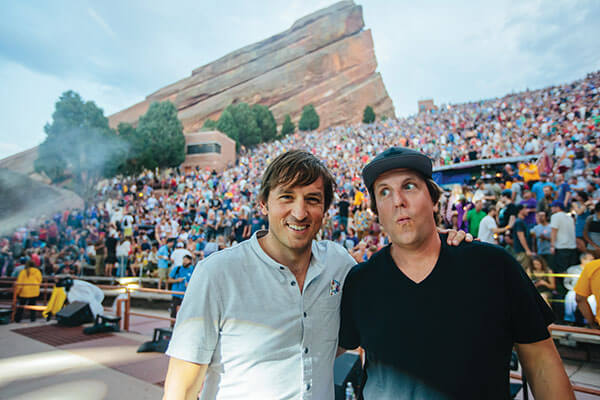
Browning was a freshman at Notre Dame when Umphrey’s McGee formed. While partying at an off-campus house one night, he walked down to the basement to discover a band playing a Phish song he liked. He was hooked. He approached Bayliss, offering to help in any way they needed and was tasked with trying to make the group sound better during their live shows. So he taught himself the skills necessary to become the band’s sound engineer. Browning served in that role — and many others — for years before joining Iwinski as one of the managers.
Both are still clearly fans of the band. At Red Rocks, Iwinski and Browning hang out on the side of the stage, bobbing their heads to the music and catching up with various friends of the band. This fandom continues to guide them as they oversee a growing business.
“The driving ethos for me has always been: What do I want to experience as a music fan?” Browning says. Umphrey’s McGee constantly communicates with its followers — on social media, through an email newsletter, on its website — and is always coming up with creative ways for fans to connect with the band.
At UMLive.net, fanatics can purchase the music from every single Umphrey’s McGee live show, either buying entire concerts or individual songs. Diehards can pay to watch certain concerts streamed live online or after the fact, and the band shares videos of live performances and some behind-the-scenes footage for free at their website and on YouTube.
“Headphones & Snowcones” (named for a song from Local Band Does O.K., the band’s third album) offers a limited number of concert-goers the ability, for $40, to don a special pair of headphones and listen to the soundboard mix of the show. And UMVIP packages give fans who pay a premium rate access to such perks as meet-and-greets with the band after the concerts.
A strong independent streak runs through Umphrey’s McGee’s business dealings. In 2014, the band launched its own record label, Nothing Too Fancy Music, which is also named after one of its early songs. The group also has partnered with Boulder Beer Company to create Nothing Too Fancy Pale Ale. This summer, the band released Reel to Real, a documentary chronicling its history. Dedicated to Mirro, who died in 2014, the film contains footage shot over the years by Browning and was directed by Jefferson Waful, the group’s lighting designer.
Perhaps the best example of the musical and business creativity of Umphrey’s McGee coming together in perfect harmony is UM Bowl. The direction of this yearly concert is determined by the fans — those at the show and watching live online. The concert is divided into four quarters, each formatted differently. In the “Raw Stewage” quarter, fans vote ahead of time on their favorites from a selection of previously performed pieces of improv, and the band takes the most popular moments and creates new songs, which are debuted at UM Bowl.
These initiatives add up not only to unique methods of engaging fans but new revenue streams as well. In the modern musical landscape, record sales can no longer be relied upon to drive profits. Live shows remain the band’s biggest moneymaker, but these extra experiences allow a business that now has 20 salaried employees to continue to grow.
That Umphrey’s McGee has a staff that size, between the road crew, the office workers and the band, underlines just how far it has come. The players graduated from a Chevy Suburban to a 15-passenger van to a tour bus. The group that made its first album in a South Bend auto shop recorded its most recent one, The London Session, in the legendary Studio 2 at Abbey Road. And it keeps drawing more fans at some of the country’s best venues, whether filling up the Beacon Theatre in Manhattan two nights in a row for three years straight or headlining for two consecutive nights at Red Rocks for the first time this summer.
How much more popular can they get? The band members don’t spend much time thinking about it. Sure, there are dream gigs. They could headline Madison Square Garden or tour Europe to tap into the bustling progressive rock scene across the pond. But the six members of Umphrey’s McGee are thrilled with their current status.
“Success, for me, is sustaining it,” Bayliss says. “I don’t have the dream of playing arenas. This is sweet.”
Another question they have little time for is how much longer they can keep this up. The musicians are now each hovering around the age of 40. They no longer live together in Chicago. Stasik and Farag live in Charleston, South Carolina, while Cummins and Myers moved to Southern California. Bayliss is still in Chicago, and Cinninger is back in South Bend. Five of the six are married, and three of them have children. But they’ve adjusted their work to fit their new lifestyles. They rehearse before every show to make up for the time they’re not together and now do roughly 90 shows per year instead of 160.
The biggest reason they have survived all these years, when so many other bands fail after just a few, is how well they still get along with each other. There have been bumps along the way, which are inevitable when you’re spending hours together on the road and your livelihoods depend on one another. But they’ve always addressed these issues head-on as a group, never letting them fester. They work on their friendships like they work on the music.
“Nobody wants to make music with somebody they’re not getting along with,” Stasik says.
This camaraderie is on display before, during, and after their two shows at Red Rocks. Just before taking the stage, the six gather in a circle. They look each other in the eyes, make sure they’re all on the same page, and then someone says something to make the other five laugh.
Midway through their show on the second night, Bayliss steps to his mic and says, “So this next one’s an old tune. It was written back in South Bend, Indiana, a long, long time ago.” At the mention of South Bend, a small but noticeable cheer arises from the crowd.
It has been a long time, and Umphrey’s McGee has come a long way — from Bridget McGuire’s to Red Rocks. Yet two constants remain: the artists’ passion for the music and their dedication to each other. At the core, Umphrey’s McGee is still six close friends traveling around the country, playing music together and living up to an audacious, late-night college pact.
And they’re not done yet.
Kevin Brennan is the alumni editor of this magazine. For access to the full shows from Red Rocks, visit https://tourgigs.com/show/umphreysmcgee_redrocks_2016/
